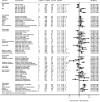Identifying predictors of ventral hernia recurrence: systematic review and meta-analysis
- PMID: 33839749
- PMCID: PMC8038271
- DOI: 10.1093/bjsopen/zraa071
Identifying predictors of ventral hernia recurrence: systematic review and meta-analysis
Erratum in
-
Corrigendum to: Identifying predictors of ventral hernia recurrence: systematic review and meta-analysis.BJS Open. 2021 May 7;5(3):zrab047. doi: 10.1093/bjsopen/zrab047. BJS Open. 2021. PMID: 34131707 Free PMC article. No abstract available.
Abstract
Background: Ventra hernias are increasing in prevalence and many recur despite attempted repair. To date, much of the literature is underpowered and divergent. As a result there is limited high quality evidence to inform surgeons succinctly which perioperative variables influence postoperative recurrence. This systematic review aimed to identify predictors of ventral hernia recurrence.
Methods: PubMed was searched for studies reporting prognostic data of ventral hernia recurrence between 1 January 1995 and 1 January 2018. Extracted data described hernia type (primary/incisional), definitions of recurrence, methods used to detect recurrence, duration of follow-up, and co-morbidity. Data were extracted for all potential predictors, estimates and thresholds described. Random-effects meta-analysis was used. Bias was assessed with a modified PROBAST (Prediction model Risk Of Bias ASsessment Tool).
Results: Screening of 18 214 abstracts yielded 274 individual studies for inclusion. Hernia recurrence was defined in 66 studies (24.1 per cent), using 41 different unstandardized definitions. Three patient variables (female sex, age 65 years or less, and BMI greater than 25, 30, 35 or 40 kg/m2), five patient co-morbidities (smoking, diabetes, chronic obstructive pulmonary disease, ASA grade III-IV, steroid use), two hernia-related variables (incisional/primary, recurrent/primary), six intraoperative variables (biological mesh, bridged repair, open versus laparoscopic surgery, suture versus mesh repair, onlay/retrorectus, intraperitoneal/retrorectus), and six postoperative variables (any complication, surgical-site occurrence, wound infection, seroma, haematoma, wound dehiscence) were identified as significant prognostic factors for hernia recurrence.
Conclusion: This study summarized the current evidence base for predicting ventral hernia recurrence. Results should inform best practice and future research.
© The Author(s) 2021. Published by Oxford University Press on behalf of BJS Society Ltd.
Figures



References
-
- Hospital Episode Statistics. UK ventral hernia data: . https://digital.nhs.uk/data-and-information/publications/statistical/hos....
-
- Shelton J, Poulose BK, Phillips S, Moore D, Nealon W, Penson D et al. Epidemiology and cost of ventral hernia repair : making the case for hernia research. Hernia 2012;16:179–183 - PubMed
-
- Hadad I, Small W, Dumanian GA. Repair of massive ventral hernias with the separation of parts technique: reversal of the ‘lost domain’. Am Surg 2009;75:301–306 - PubMed
-
- Cobb WS, Warren JA, Ewing JA, Burnikel A, Merchant M, Carbonell AM. Open retromuscular mesh repair of complex incisional hernia: predictors of wound events and recurrence. J Am Coll Surg 2015;220:606–613 - PubMed
-
- Rosen MJ, Krpata DM, Ermlich B, Blatnik JA. A 5-year clinical experience with single-staged repairs of infected and contaminated abdominal wall defects utilizing biologic mesh. Ann Surg 2013;257:991–996 - PubMed
Publication types
MeSH terms
LinkOut - more resources
Full Text Sources
Other Literature Sources
Medical
Research Materials

